Serviços Personalizados
Journal
Artigo
Indicadores
-
 Citado por SciELO
Citado por SciELO -
 Acessos
Acessos
Links relacionados
-
 Similares em
SciELO
Similares em
SciELO
Compartilhar
Ciência e Técnica Vitivinícola
versão impressa ISSN 0254-0223
Ciência Téc. Vitiv. vol.27 no.2 Dois Portos dez. 2012
Vineyard weed community dynamics in the Dão winegrowing region
Dinâmica da vegetação infestante das vinhas da região vitivinícola do Dão
Ana Monteiro*, Fátima Caetano, Teresa Vasconcelos, Carlos M. Lopes
Instituto Superior de Agronomia, Universidade Técnica de Lisboa, Centro de Botânica Aplicada à Agricultura, Tapada da Ajuda, 1349-017 Lisbon, Portugal, e-mail: anamonteiro@isa.utl.pt; carlosmlopes@isa.utl.pt; tvasconcelos@isa.utl.pt
*Corresponding author:
SUMMARY
With the aim of analysing the influence of both the sub-region and weed-control practices on vegetation composition and dynamics in the Portuguese Dão Winegrowing Region, 120 vineyards were surveyed for weeds and winegrowers were asked to respond to a questionnaire in 2008. 206 taxa distributed across 31 families were recorded, with a predominance of Fabaceae, Asteraceae and Poaceae. The predominant vineyard inter-row soil management techniques were cropping (53%), with some cover sown but mostly relying on resident vegetation, and soil tillage (31%). Herbicides were applied in the row in 46%, and in the overall area in 4%, of the vineyards. Canonical correspondence analysis revealed significant effects of the sub-region and the different soil management strategies on vineyard community structure. Compared with the last (and only) study, which took place in 1950, weed composition was different and species diversity increased. The present study showed that resident vegetation also increased plant diversity. The dynamics of the perennial weed species Cynodon dactylon and Convolvulus arvensis must be carefully evaluated in order to avoid severe competition with the vine.
Key words: weeds, soil management, biodiversity, Vitis vinifera
RESUMO
Com o objetivo de avaliar a influência da sub-região e dos métodos de gestão do solo da vinha na composição e dinâmica da vegetação infestante, no final do Inverno de 2008, foram efetuados 120 levantamentos florísticos e inquéritos aos viticultores nas sete sub-regiões da região vitivinícola do Dão. Registaram-se 206 táxones, distribuídos por 31 famílias, com predominância das Fabaceae, Asteraceae e Poaceae. Em mais de metade das vinhas (53%) procedia-se ao enrelvamento na entrelinha, semeado ou, predominantemente, natural, e num terço (31%) à mobilização total. Relativamente à aplicação de herbicidas, em 4% das vinhas fazia-se monda química em toda a área e em 46% aplicavam-se herbicidas na linha. A aplicação da análise canónica de correspondências mostrou que a composição da vegetação infestante presente nas vinhas era influenciada quer pela sub-região quer pela técnica de gestão do solo. Verificou-se um aumento na diversidade florística em relação ao último e único estudo efetuado em 1950. O nosso estudo mostrou ainda que o enrelvamento natural também aumentou a diversidade florística. A dinâmica das infestantes perenes como Cynodon dactylon e Convolvulus arvensis, presentes em todos os sistemas de de gestão do solo inventariados, exige um adequado programa de controlo de forma a evitar situações de elevada competição com a videira.
Palavras-chave: infestantes, gestão do solo, biodiversidade, Vitis vinifera
INTRODUCTION
After the advent of herbicides and until recently, Portuguese vineyard soil management practices typically involved integrating soil tillage in the inter row with post- and pre-emergence herbicides in the row, with less emphasis on the incorporation of other control methods (Monteiro and Moreira, 2004). In the last two decades, vineyard soil management systems have been changing in Portugal; however, information about the importance of the methods applied and their implications for weed community dynamics is scarce. The need to reduce costs and make grape production more sustainable has prompted the use of alternative weed control practices that optimize production while maintaining profits. Cover cropping is consequently gaining popularity among Portuguese winegrowers.
Vineyard natural cover cropping can cause significant reductions in vine vegetative growth and yield, because the swards compete with vines for water and nutrients (Afonso et al., 2003; Celette et al., 2008; Lopes et al., 2011; Monteiro et al., 2012). Other studies in Portugal have shown that in some viticultural regions, resident vegetation can also be an important ecological vineyard management tool for controlling vigour and enhancing wine quality (Monteiro and Lopes, 2007; Lopes et al., 2008) and reducing pest densities (Campos et al., 2006).
The opinion that plant identification, plant richness (number of species) and diversity (relative abundance of species) play a major role in contributing to human welfare is emerging in land and crop management. Indeed, knowledge of the distribution and infestation of plant communities and the ecological factors involved in their diversity and variability is a determinant factor in rational weed control (Michez and Guillerm, 1984). Species compositional changes have been observed for different weed management systems (Wrucke and Arnold, 1985; Teasdale et al., 1991; Monteiro et al., 2008). Some weed species do not display a unique association with management practices, growing equally well in all systems. Zaragoza et al. (1989) reported that species number can be significantly reduced in no-till herbicide systems, but that annual grasses and perennial weed species predominate.
The identification of vineyard weeds and their relationship with ecological factors are well documented for most Portuguese winegrowing regions (Cerejeira, 1985; Barata, 1987; Espírito Santo, 1987; Ribeiro, 1988; Lopes, 1989; Moreira, 1990; Aguiar, 1992; Mira et al., 1999; Espírito Santo et al., 2000), but there is a paucity of published research on vineyard weed communities in the Dão winegrowing region. A single study on 26 mostly manually cultivated vineyards was carried out in 1950 (Pinto da Silva, 1971). However, the viticulture of the Dão is of great economic, importance because it covers about 20.000 ha, or 16% of the regions total agricultural area (Afonso, 2003). There is therefore a need for further studies on weed management strategies across the entire region and the response to them in terms of weed community dynamics.
At the same time, sustainable viticulture needs a multistrategy approach where weeds are responsive not only to weed control, but also to numerous other facets of viticulture. When the winegrower chooses a natural (resident vegetation) or sown cover crop, information about plant species that adapt well to the relevant ecological and agronomical factors is fundamental in order to avoid negative impacts on wine grape production. Annual plant species with a short life cycle and auto-sown or perennials that regenerate soon after the first autumn rains, preferably with low water consumption (Lopes et al., 2004), are recommended. There is also a need for research on cover cropping plant species (which are frequently considered to be weeds), as they might enhance biodiversity, wine quality and vineyard aesthetics, all of which are very important to the recent increase in the agro-tourism business. The present projects objectives were thus to use the weed-vineyard and winegrower surveys to: (1) characterize weed composition and density; (2) evaluate the ecological influence (sub-region) on plant-species composition and diversity in order to identify appropriate plant species for cover cropping; and (3) determine which soil management practices are used and their effects on weed community composition.
MATERIAL AND METHODS
The study was conducted in commercial vineyards throughout the Dão winegrowing region, Central Portugal, from March until May 2008. Vineyard-vegetation and winegrower surveys (120) were carried out in the seven Dão sub-regions. The site location of each survey is described by Caetano (2009). Individual plant species density was estimated using the scale proposed by Barralis (1975), where 1 = < 1; 2 = 1 to 2; 3 = 3 to 20; 4 = 21 to 50; and 5 > 51 plants/m2. The average density (D), absolute frequency (FA) and relative frequency (FR) for each species per survey were then calculated according to Barralis (1976):
D = (0.5n1+1.5n2+11.5n3+35.5n4+75.5n5)/(n1+n2+n3+n4+n5) (eq. 1)
n1, n2, n3, n4, n5 – number of surveys where the species presented a density of 1, 2, 3, 4 and 5, respectively;
FA = n – a (eq. 2)
n – total number of surveys;
a – number of surveys where the species was absent;
FR = 100*(n – a) / n (eq. 3)
The weed infestation degree was evaluated according to Michez and Guillerm (1984) in a plot created by the relationship between FR (abscissa) and D (ordinate).
Plant species were also grouped according to annual broad-leaved species, annual grass species, perennial broad-leaved species, perennial grass species and other monocotyledons.
Canonical correspondence analysis (CCA) was used to elucidate weed community structure and associations, as they might be affected by geographical location (sub-region) and by soil management practices in the inter-row (treatments) (ter Braak and Smilauer, 1998). Analysis was based on weed species density per survey. Treatments were treated as independent variables and species density as dependent variables. The geographic variables were the seven sub-regions: Alva, Besteiros, Castendo, Serra da Estrela, Silgueiros, Terras de Azurara, and Terras de Senhorim. The soil management practice variables were: soil tillage (MOB), chemical control (HERB), resident vegetation (RNA), and sown cover crop (RSE). CCA was performed in CANOCO (Canoco for Windows version 4.5), with axis scores centred to interspecies distances and biplot scaling. Automatic forward selection with Monte Carlo permutation test was used to determine the significance of the treatments. Treatment centroids and canonical coefficients for the species are presented in biplots. Proximity of species score to a treatment centroid signifies that the species had the highest density in that treatment.
RESULTS AND DISCUSSION
Weed vegetation composition and diversity
A total of 206 taxa were surveyed in inter-row for the region as a whole (Table I). In 1950, Pinto da Silva (1971) identified 84 taxa as dominants and 60 as casuals. Most of these 144 taxa were also recorded in the present study.
TABLE I
The observed taxa are distributed across 31 families, with Fabaceae, Asteraceae, Poaceae and Caryophyllaceae the dominant ones (Table II). Considering only the dominant taxa referred by Pinto da Silva (1971) 60 years ago, the main families were Asteraceae (25%), Poaceae 20.2%), Caryophyllaceae (8.3%), and Fabaceae (4.8%). For the casual species in the same study, Fabaceae represented 10% a value that is lower than the one recorded in the present study. In our study the three dominant families included 55% of the total surveyed taxa. This percentage was higher than in other portuguese viticultural regions, as evidenced by Cerejeira (1985) in the Ribatejo (40.7%), Barata (1987) in Palmela, Sesimbra and Setúbal 37%), Espírito Santo (1987) in Bombarral (46.7%), Ribeiro (1988) in the Douro (37%), Lopes (1989) in Bairrada (40%), Aguiar (1992) in Óbidos (41%) and Mira et al. (1999) in Évora and Borba (50%).
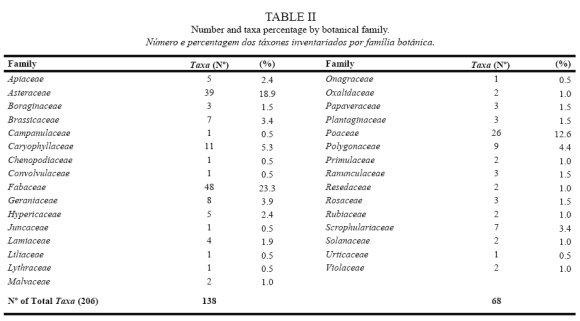
The relationship between weed relative frequency and average species density is illustrated in Figure 1 and the corresponding values are presented in Table I. Taxa with a very high infestation degree (group ++++) were not found in Dão vineyards.
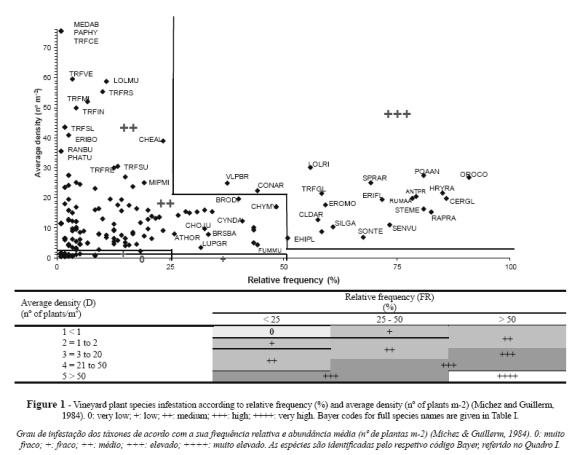
Many species with a high infestation degree (group +++) were found in the surveys – e.g. the annual broad-leaved species Chamaemelum fuscatum, Conyza albida, Ornithopus compressus, Spergula arvensis and Trifolium glomeratum, the annual grass species Lolium rigidum, Poa annua and Vulpia bromoides and the perennial broad-leaved species Convolvulus arvensis and Hypochaeris radicata.Most of the recorded species in the high infestation group are winter annuals whose growth season ended in late spring. Particular attention must be paid to the genus Conyza, because C. albida was found throughout the Dão region, while C. bonariensis was only observed in the Serra da Estrela and Alva sub-regions. The species in this genus frequently behave like perennials in cover-cropping systems, increasing their density annually. Controlling Conyza spp. chemically is difficult because the efficacy of the registered herbicides for vineyards is low.
A considerable number of species with a medium degree of infestation (group ++) were recorded as both annuals and perennials. Most of the annual grass species were included in this group (Agrostis sp., Avena spp., Bromus spp., Hordeum sp. Lolium multiflorum, Poa annua, Vulpia geniculata), as were some Fabaceae species that are appropriate for cover cropping – e.g. Medicago arabica, Lotus conimbricensis, Lotus hispidus (Serra da Estrela sub-region only), Lupinus angustifolius ssp . reticulatus, L. gredensis, L. luteus, Ornithopus pinnatus, O. sativus ssp. isthmocarpus, Trifolium cernuum, T. incarnatum, T. michelianum, T. repens, T. resupinatum and T. vesiculosum (Table I; Figure 1). Some perennial broad-leaved species (Andryala integrifolia, Chondrilla juncea, Plantago lanceolata, Rumex pulcher) and the perennial grass Cynodon dactylon also displayed a medium degree of infestation. In general, these species were found throughout the region and seemed well adapted to the different management practices. Most of these taxa were also considered weeds by Pinto da Silva (1971) and, if improperly managed, they could be water-competitive with the vines due to their deep roots. Cynodon dactylon rhizomes can grow deep and regenerate even at 40 cm depth (Moreira, 1978).
Finally, the low (+) and very low (0) infestation groups comprise about 20% of the species we found (Table I, noted only in the lower left corner of Figure 1).
Effect of sub-region on weed communities
Canonical correspondence analysis (CCA) revealed significant community differences among sub-regions (Figure 2). Although all the species recorded were included in the multivariate analysis, only those with the greatest ability to explain the differences between sub-regions are shown in Figure 2. The first canonical axis in the biplot of flora species explained 26.5% of the variance between sub-regions, while the second axis explained 22.3%. Based on the ordination diagram, five groups of weed species are well related with one or more particular sub-regions. The weed communities associated with the Serra de Estrela (rSE = -0.71) were distinct from those linked to Besteiros (rBEST = 0.85), as can be seen from its opposite position on axis 1; Terras de Senhorim (rTERSE = 0.70) was distinct from Alva (rALV = 0.33), based on its opposite position on axis 2. The weed communities associated with Terras de Azurara, Castendo and Silgueiros were similar, all positively related with axis 2. Having said this, many taxa have scores close to the axis origins, indicating their ubiquity in all sub-regions, and others were surveyed in more than, or only, one sub-region (Table I; Figure 2). The combination of the data presented by sub-region in Table I with Figure 2 revealed a large number of weed species associated with each of the five sub-regional groups.
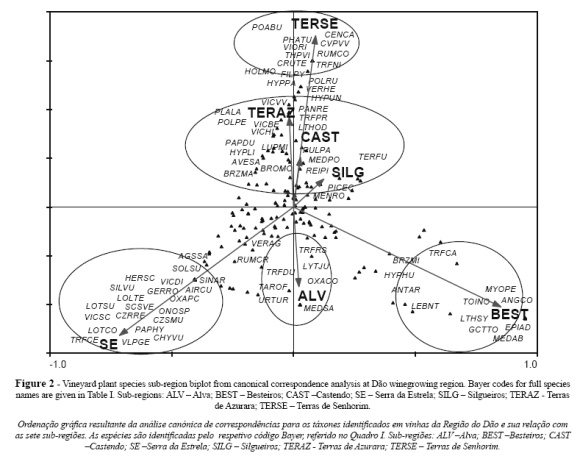
When considering the species with specific interest for cover cropping and with high value for vineyard agro-tourism, we observed that:
i) The Serra da Estrela sub-region was associated with the presence of Agrotis pourretii, Vulpia geniculata, Lotus corniculatus ssp. corniculatus, L. hispidus, Ononis spinosa, Trifolium cernuum, Vicia cordata, and the Papaveraceae Papaver hybridum.
ii) In the Alva sub-region Medicago sativa, Trifolium dubium and Lytrum junceum, and in Besteiros Lathyrus sylvestris, Medicago arabica, Epilobum tetragonum, Galactites tomentosa, Anagallis arvensis var. caerulea, Torilis nodosa, Ranunculus bulbosus and Myosotis persoonii, particularly stand out.
iii) The following taxa were associated with the Terras de Senhorim sub-region: Trifolium nigrum, Poa bulbosa, Centhranthus calcitrapae, Filago pyramidata and Phalaris aquatica.
iv) The group composed of the Terras de Azurara, Castendo and Silgueiros sub-regions was correlated with many species, such as Vicia dasycarpa, V. benghalensis, Trifolium pratense, V. hirsuta, Taraxacum fulvum, and Pulicaria paludosa.
Effect of soil management on weed communities
The surveyed vineyard soil management practices are shown in detail in Figure 3. Looking solely at the inter-row practices, the resident vegetation was used in 47% of the surveyed vineyards, sown cover cropping in 6%, soil tillage in 41%, and chemical control in 6%. Total soil tillage was carried out in 31% of the vineyards and inter row tillage were managed in 10% of vineyards surveyed. Herbicides were also applied before vine budbreak in 46% of the rows (Figure 3). Glyphosate was applied alone (45%) or in mixture (38%) with other active ingredients (diflufenican + glyphosate, diuron + glyphosate + terbutylazin, and glyphosate + linuron + terbutylazin). Glyphosate was thus always applied. Particular attention must be paid to glyphosate resistance in weeds. Species of the genus Conyza and Lolium are already resistant to glyphosate in the Alentejo (olive orchard) and Douro (vineyard) regions (Calha and Osuna, 2010; Mendes et al., 2011; Calha and Portugal, 2012; Portugal et al., 2012).
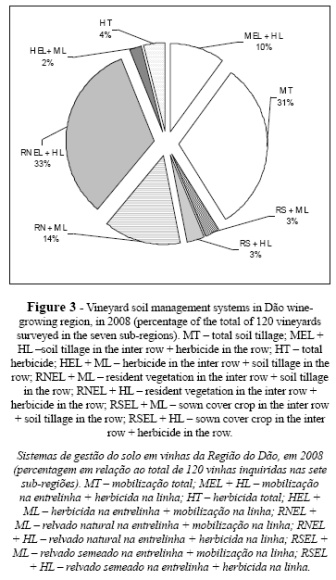
Our data show that soil management practices had a clear significant effect on weed communities (Figure 4). The plant species presented in the communities separated by CCA fitted into one of three categories: ubiquitous among treatments (e.g. Convolvulus arvensis, Cynodon dactylon, Lolium rigidum; Trifolium glomeratum, Vicia lutea, among others), hence their position near the origin of the biplot; sporadically present in a given treatment (e.g. Anagallis arvensis var. caerulea; Crepis versicaria and Jasione montana); and dominant in some treatments (e.g. Bromus madritensis and Trifolium repens) (Table I). Figure 4 and Table I also highlight the fact that the plant species Scorpiurus vermiculatus and Arabidopsis thaliana were only presented in RNA, while several species of the genus Trifolium and Phalaris aquatica were associated with RSE. A large number of annual species were surveyed in the soil tillage treatment (MOB).
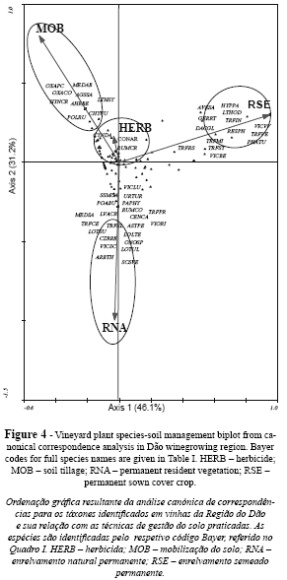
Despite being ubiquitous among treatments, the perennial species Cynodon dactylon, Convolvulus arvensis and Rumex crispus were more abundant in the vineyards submitted to weed chemical control. Other authors, for different ecosystems and crops, have found a similar effect of soil management practices on weed dynamics – namely an increase in biodiversity because the resident vegetation is retained (Wrucke and Arnold, 1985; Teasdale et al., 1991; Naeem et al., 1999; Afonso et al., 2003; Hiltbrunner et al., 2007; Monteiro et al., 2008).
In the spring of 2008, most of the surveyed vineyard rows displayed a very good weed control. Weeds were recorded in only 16% of the surveyed vineyards and their abundance was very low. The species Spergula arvensis, Poa annua, Erodium moschatum, Hypochaeris radicata and Cerastium glomeratum were more frequent in the herbicide row treatment, while Lupinus micranthus, Vicia lutea, Vicia angustifolia, Cynodon dactylon, Convolvulus arvensis and Avena barbata were favoured by soil tillage.
Winegrower questionnaires also showed that soil tillage was carried out using a cultivator (27%), a disk harrow (18%), a rotary tiller (24%), or a combination of a disk harrow and then a cultivator (31%).
CONCLUSIONS
The present study revealed that changes in weed flora have occurred in the Dão winegrowing region in the last 60 years, with an increase in diversity. More than 200 taxa belonging to 31 families were surveyed. Despite the five plant groups separated by CCA, the dominant weed species were found throughout the Dão winegrowing region.
The study also showed that permanent natural cover cropping (RNA) could be an appropriate soil management method, since it increased plant diversity, particularly in terms of the richness of grass and legume plant species and troublesome weeds were not favoured. Nevertheless, studies concerning RNA effects on vines should be carried out.
Species of the genus Ornithopus, Trifolium, Vicia, Lolium and the species Poa annua were very frequent and abundant overall the region and in the four management soil treatments. These taxa are annuals with a short life cycle, and are recommended for cover cropping due to the lower risk of water competition with vines and nitrogen assimilation by legumes. Nevertheless, the dynamic of perennial species – e.g. Convolvulus arvensis and Cynodon dactylon – that were abundant and ubiquitous among treatments, must be carefully evaluated, especially with regard to herbicide use and time of application. Since glyphosate has always been applied in the vineyards, particular attention must be paid to ghyphosate weed resistance in the region.
ACKNOWLEDGEMENTS
The authors would like to thank Vanda Pedroso from the Centro de Estudos Vitivinícolas do Dão, Quadrado de Sousa from Zona Agrária de Gouveia, José Bernardo from Oliveira do Hospital, and the technicians Luís de Sousa, Vítor Figueiredo and Emílio Figueiredo, for their technical support. We are also grateful to the viticultural technicians and winegrowers who kindly responded to the questionnaires. We also thank the anonymous referees for their constructive comments on an earlier version of the manuscript.
REFERENCES
Afonso F., Afonso J.M., Vasconcelos M.T., Monteiro A. 2001. Malas hierbas de los viñedos de la Subregion Vitícola de Monção – Region de los Vinhos Verdes. Actas Congresso 2001 de la Sociedad Española, 65-69. [ Links ]
Afonso J., 2003. Anuário de Vinhos, 2004. Edições Cotovia. 398 [ Links ]
Afonso J.M., Monteiro A., Lopes C.M., Lourenço J., 2003. Enrelvamento do solo em vinha na regiao dos Vinhos Verdes. Três anos de estudo na casta Alvarinho Ciência Téc. Vitiv. 18, 47-63.
Aguiar F.C.F., 1992. Infestantes das Vinhas da Zona Vitivinícola de Óbidos: Caracterização e Análise Ecológica. Relatório do Trabalho de Fim do Curso de Engenharia Agronómica. Instituto Superior de Agronomia. Universidade Técnica de Lisboa. [ Links ]
Barata A.M., 1987. Estudo florístico das vinhas dos concelhos de Palmela, Sesimbra e Setúbal. Jornadas sobre sistemas culturais do solo e protecção na vinha. Escola Superior Agrária de Santarém, 1-26. [ Links ]
Barralis G., 1975. Résultats dune acquête sur la répartition et la densité des mauvaises herbes en France. Proc. 8 ème Conférence du COLUMA4, 1042-1058. [ Links ]
Caetano M.F.P.B., 2009.Flora das vinhas da Região Demarcada do Dão . Dissertação para a obtenção do Grau de Mestre em Engenharia Agronómica, Instituto Superior de Agronomia, Universidade Técnica de Lisboa. [ Links ]
Calha I.M., Osuna M.D. 2010. Herbicide Weed Resistance in Portuguese Olive Groves. AFPP - 21st COLUMA Conference, International Meeting On Weed Control, 8-9 December. Dijon, França. [ Links ]
Calha I.M., Portugal J., 2012.Glyphosate resistance status and potential solutions in Portugal. International Workshop on European status and solutions for glyphosate resistance Córdoba, May 2012, Spain. [ Links ]
Campos L., Franco J.C., Monteiro A., Lopes C., 2006. Influência do enrelvamento na abundância de artrópodes associados a uma vinha da Estremadura. Ciência Téc. Vitiv21, 33-46. [ Links ]
Celette, F., Gaudin, R., Gary, C., 2008. Spatial and temporal changes to the water regime of a Mediterranean vineyard due to the adoption of cover cropping. Eur.J. Agron.29, 153–162. [ Links ]
Espírito Santo M.D., 1987. Evolução da vegetação infestante das vinhas do Concelho do Bombarral. 73 p. Dissertação para prestação de Provas de Acesso à Categoria de Investigador Auxiliar, Instituto Superior de Agronomia, Universidade Técnica de Lisboa. [ Links ]
Espírito Santo M.D., Moreira I., Guillerm J.L., Barata A., Cerejeira M.J., Lopes M.C., Ribeiro J.A., Sá G., 2000. Main weeds of vineyards in Portugal. Protecção da Produção Agrícola 2000/1, 107-123. [ Links ]
Hiltbrunner J, Scherrer C, Streit B, Jeanneret P, Zihlmann U., Tschatli R 2007. Long-tem weed community dynamics in Swiss organic and integrated farming systems. Weed Research, 48, 360-369. [ Links ]
Cerejeira M.J.A.P.A., 1985. Ecologia da vegetação das vinhas do Ribatejo. 166 p. Dissertação do Mestrado em Produção Vegetal. Instituto Superior de Agronomia, Universidade Técnica de Lisboa. [ Links ]
Lopes C., Monteiro A., Rückert E., Grüber B., Steinberg B., Schultz H.R., 2004. Transpiration of grapevines and co-habitating cover crop and weed species in a vineyard. A snapshot at diurnal trends. Vitis, 43, 111-117. [ Links ]
Lopes C.M., Monteiro A., Machado J.P., Fernandes N., Araújo A., 2008. Cover cropping in a sloping non-irrigated vineyard: II - Effects on vegetative growth, yield, berry and wine quality of Cabernet sauvignon grapevines. Ciência Téc. Vitiv., 23, 37-43. [ Links ]
Lopes C.M., Santos, T.P. Monteiro, A. Rodrigues M.L., Costa, J.M., Chaves M.M., 2011 Combining cover cropping with deficit irrigation in a Mediterranean low vigor vineyard.Scientia Horticulturae,129, 603–612. [ Links ]
Lopes M.C.R., 1989. Ecologia da flora das vinhas da Bairrada. Dissertação do Curso de Mestrado em Produção Vegetal. Instituto Superior de Agronomia, Universidade Técnica de Lisboa. [ Links ]
Mendes S., Portugal J., Calha I.M. 2011. Prospecção de resistência ao glyphosate em populações de Conyza canadensis. Livro de resumos do 9º Encontro Nacional de Protecção Integrada (9ENPI): 93. [ Links ]
Michez M.,e Guillerm J.L., 1984. Signalement écologique et degré d'infestation des adventices des cultures d'été en Lauragais. Proc. 7ème Coll. Int. Ecol. Biol. Mauvaises Herbes1, 155-162. [ Links ]
Mira C.A., Sousa M.E., Portugal J.M., 1999. Estudo preliminar da flora infestante em vinhas da região de Évora e Borba. Actas V Encontro Nacional de Protecção Integrada. A prática da protecção integrada no limiar do milénio. Escola Superior Agrária de Bragança, 104-109. [ Links ]
Monteiro A., Lopes C.M., 2007. Influence of cover crop on water use and performance of vineyard in Mediterranean Portugal. Agriculture, Ecosystems and Environment121, 336-342. [ Links ]
Monteiro A., Lopes C.M., Machado J.P., Fernandes N., Araújo A., Moreira I., 2008. Cover cropping in a sloping, non-irrigated vineyard: I – Effects on weed composition and dynamics.Ciência Téc. Vitiv.,23, 29-36. [ Links ]
Monteiro A., Moreira I., 2004. Reduced rates of pre-emergence and post-emergence herbicides for weed control in vineyards. Weed Res., 44, 117-128. [ Links ]
Monteiro A., Lopes C.M., Franco, J.C., 2012 Enrelvamento da Vinha. In: Gestão e conservação da flora e da vegetação de Portugal e de África Lusófona. In Honorium do Professor Catedrático Emérito Ilídio Rosário dos Santos Moreira. 377-402. Monteiro A., Gomes da Silva F., Raul J. (Eds.) ISAPress. Lisbon. [ Links ]
Moreira I., 1978. Influência da profundidade de enterramento de fragmentos de rizoma na regeneração de plantas de Cynodon dactylon (L.) Pers. e de Panicum repens L.Rev. Ciências Agrárias, 2, 111-127. [ Links ]
Moreira I., 1990. Estudos de herbologia da vinha, em Portugal. Phytoma Espana, 23,23-36. [ Links ]
Naeem S., Chapin III F.S., Costanza R., Ehrlich P.R., Golley F.B., Hooper D.U., Lawton J.H., ONeill R.V., Mooney H.A., Sala O.E., Symstad A.J., Tilman D. 1999. Biodiversity and ecosystem functioning: Maintaining natural life support processes.Issues in Ecology, 4.Washington, D.C.; Ecological Society of America. [ Links ]
Pinto da Silva A.R., 1971. A vegetação dos Vinhedos Portugueses. O Brassicetum Barrelieri. Agronomia Lusitana, 32, 229 – 250. [ Links ]
Portugal J., Calha I.M., Gonzalez-Torralva. F, Roldan R., DePrado R., 2012. Management strategies for Lolium sp. resistant to glyphosate with herbicide programs. Proc. International Workshop on European status and solutions for glyphosate resistance. Córdoba, May 2012, Spain. [ Links ]
Ribeiro J.A., 1988. Ecologia da vegetação das vinhas do Alto Douro. 299. Dissertação para obtenção do grau de Doutor em Engenharia Agrícola. Universidade de Trás-os-Montes e Alto Douro, Vila Real. [ Links ]
Teasdale J.R., Beste C.E., Potts W.E., 1991. Response of weeds to tillage and cover crop residue. Weed Science, 39, 195-199. [ Links ]
Braak C.J.F. e milauer P., 1998. CANOCO reference manual and users guide to CANOCO for Windows: software for canonical community ordination. Version 4. Microcomputer Power, Ithaca, New York, USA. [ Links ]
Wrucke M.A., Arnold E., 1985. Weed species distribution as influenced by tillage and herbicides. Weed Science, 33, 853-856. [ Links ]
Zaragoza C., Sopena J.M., Ochoa M.J., Aibar j., Gomez-Aparisi J., 1989. Weed flora evolution in vineyards under different soil management systems. Proc. 4th EWRS Symposium on Weed Problems in Mediterranean climates, 1, 251-262. [ Links ]
*Corresponding author:
Tel: +351 213 653 162; Fax: +351 213 635 031, e-mail address: anamonteiro@isa.utl.pt
(Manuscrito recebido em 16.10.2012. Aceite para publicação em 08.01.2013)













